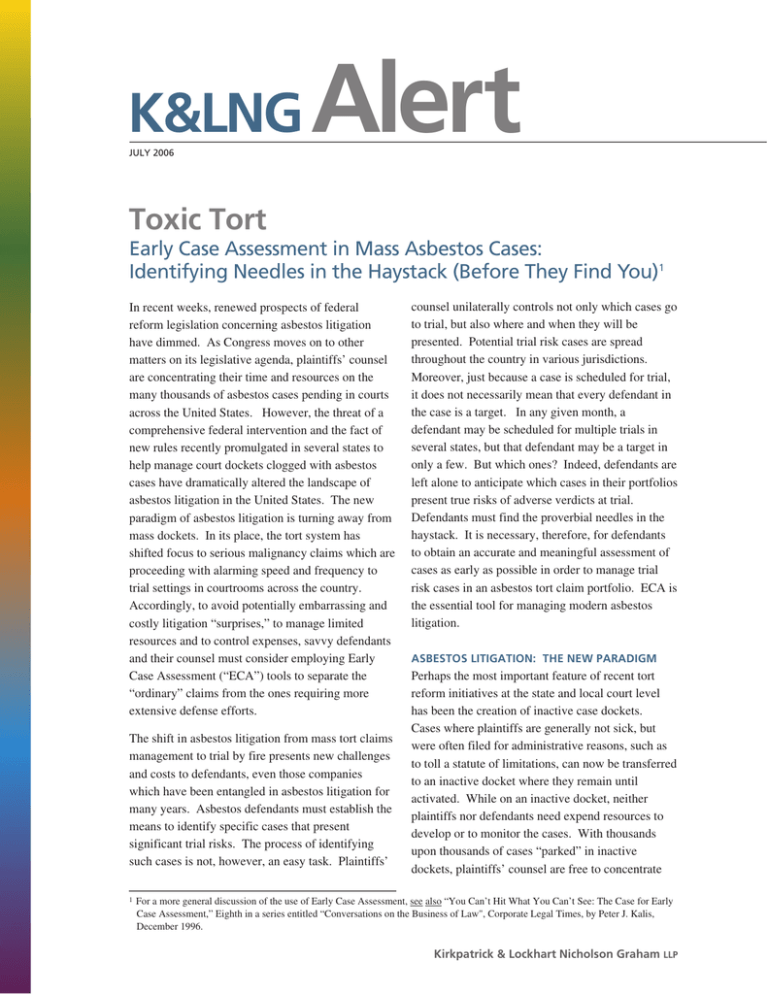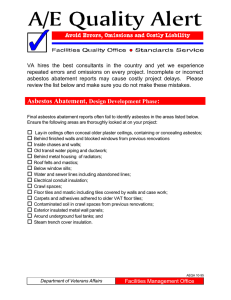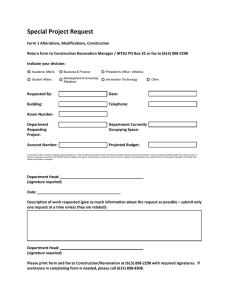
K&LNG
JULY 2006
Alert
Toxic Tort
Early Case Assessment in Mass Asbestos Cases:
Identifying Needles in the Haystack (Before They Find You)1
In recent weeks, renewed prospects of federal
reform legislation concerning asbestos litigation
have dimmed. As Congress moves on to other
matters on its legislative agenda, plaintiffs’ counsel
are concentrating their time and resources on the
many thousands of asbestos cases pending in courts
across the United States. However, the threat of a
comprehensive federal intervention and the fact of
new rules recently promulgated in several states to
help manage court dockets clogged with asbestos
cases have dramatically altered the landscape of
asbestos litigation in the United States. The new
paradigm of asbestos litigation is turning away from
mass dockets. In its place, the tort system has
shifted focus to serious malignancy claims which are
proceeding with alarming speed and frequency to
trial settings in courtrooms across the country.
Accordingly, to avoid potentially embarrassing and
costly litigation “surprises,” to manage limited
resources and to control expenses, savvy defendants
and their counsel must consider employing Early
Case Assessment (“ECA”) tools to separate the
“ordinary” claims from the ones requiring more
extensive defense efforts.
The shift in asbestos litigation from mass tort claims
management to trial by fire presents new challenges
and costs to defendants, even those companies
which have been entangled in asbestos litigation for
many years. Asbestos defendants must establish the
means to identify specific cases that present
significant trial risks. The process of identifying
such cases is not, however, an easy task. Plaintiffs’
1
counsel unilaterally controls not only which cases go
to trial, but also where and when they will be
presented. Potential trial risk cases are spread
throughout the country in various jurisdictions.
Moreover, just because a case is scheduled for trial,
it does not necessarily mean that every defendant in
the case is a target. In any given month, a
defendant may be scheduled for multiple trials in
several states, but that defendant may be a target in
only a few. But which ones? Indeed, defendants are
left alone to anticipate which cases in their portfolios
present true risks of adverse verdicts at trial.
Defendants must find the proverbial needles in the
haystack. It is necessary, therefore, for defendants
to obtain an accurate and meaningful assessment of
cases as early as possible in order to manage trial
risk cases in an asbestos tort claim portfolio. ECA is
the essential tool for managing modern asbestos
litigation.
ASBESTOS LITIGATION: THE NEW PARADIGM
Perhaps the most important feature of recent tort
reform initiatives at the state and local court level
has been the creation of inactive case dockets.
Cases where plaintiffs are generally not sick, but
were often filed for administrative reasons, such as
to toll a statute of limitations, can now be transferred
to an inactive docket where they remain until
activated. While on an inactive docket, neither
plaintiffs nor defendants need expend resources to
develop or to monitor the cases. With thousands
upon thousands of cases “parked” in inactive
dockets, plaintiffs’ counsel are free to concentrate
For a more general discussion of the use of Early Case Assessment, see also “You Can’t Hit What You Can’t See: The Case for Early
Case Assessment,” Eighth in a series entitled “Conversations on the Business of Law", Corporate Legal Times, by Peter J. Kalis,
December 1996.
Kirkpatrick & Lockhart Nicholson Graham LLP
their efforts on their clients who are indeed ill. Most
of these cases, particularly those with appealing fact
patterns, are pressed forward to a jury trial date as
soon as possible. In some states, for example, a trial
can be scheduled within only a few weeks or months
from the filing of the original complaint. Many
defendants which have grown accustomed to the
frustratingly slow progress of civil cases in most
contexts are astonished and sometimes caught offguard by the relatively rapid pace of asbestos
litigation these days.
Evaluation of the relative risk presented by asbestos
claims headed for trial depends on a series of factual
indicators about the plaintiffs, the facts of the case,
and plaintiffs’ counsel. The following is a general
discussion of some key indicators; however, it is
worth noting that several defendants present issues
that are not necessarily addressed by this noncomprehensive list.
The Alleged Disease: Because
mesothelioma claims are often considered
the signature disease of asbestos exposure
and because the disease is most often fatal, a
“meso” claim generally presents a higher
trial risk than any other cancer claim, such as
lung cancer, which has multiple other
causes. That said, certain kinds of non-meso
lung cancers are every bit as dangerous of a
trial risk.
n
Amount of Economic Losses: The potential
for economic loss involves a number of subfactors, including the plaintiff’s age, his
work status, the age and identity of any
dependents, and future earning capacity.
The more the economic loss, the greater the
potential damages and, perhaps more
importantly, the more sympathetic a plaintiff
may appear to a jury. As with mesothelioma
claims, cases that naturally appeal to jurors’
sympathy present greater potential trial risks.
n
Product Identification: The fact remains
that many asbestos suits are originally filed
against defendants based on preliminary,
unconfirmed information. As a case
proceeds toward trial, actual identification of
a defendant’s product as an alleged source of
asbestos exposure may or may not surface.
In those cases where a defendant’s product is
identified, it is important to know the extent
to which such product, and its ability to
generate potentially hazardous forms of
asbestos, is known by the prescient
witnesses.
n
Occupational Relevance: The relationship,
if any, between the plaintiff’s occupation and
work with or around the company’s product
further characterizes the product
identification.
So-called “rocket dockets” allow plaintiffs’ counsel
to maximize the overall values of cases by
leveraging trial risks against defendants in two
important ways: first, a defendant is forced to
engage in extensive and very expensive pretrial and
trial preparation over a condensed period of time;
and second, since plaintiffs’ counsel often migrate
their trial claims toward courts and jury pools known
for plaintiff-friendly rulings and verdicts in asbestos
cases, the potential for adverse jury verdicts against
defendants— even in a marginal case—is very real.
If nothing else, the plaintiffs’ new strategy in
asbestos cases certainly gets defendants’ attention
with huge increases in costs of defense and everincreasing risks of adverse jury verdicts.
n
MEETING THE CHALLENGE OF THE NEW
PARADIGM: EARLY CASE ASSESSMENT
Any ECA system should be a highly customized tool
used to identify trial risk cases in time sufficient to
bring appropriate litigation resources where they are
needed and to keep always vigilant to new, and
sometimes unexpected, challenges facing asbestos
defendants. One size does not, however, fit all
circumstances. This Alert, therefore, not only
promotes the concept of ECA in asbestos cases, but
it also discusses some core features that any ECA
should embrace.
A trial risk case is any claim that has a likelihood (or
certainty) of overcoming summary judgment and
proceeding to a trial call. Trial risk cases also
typically feature a substantial settlement demand and
the potential for an adverse verdict. Individual
cases, however, present different degrees of trial
risk. An ECA program must, therefore, be flexible
enough to measure risks on a relative scale.
2
Kirkpatrick & Lockhart Nicholson Graham
LLP
|
JULY 2006
Plaintiffs’ Counsel: As a general
proposition, the plaintiffs’ bar in the asbestos
tort system is highly organized and skilled,
particularly at preparing cases for trial
efficiently. A few firms are also particularly
adept at trying asbestos cases and fewer still
are a constant threat to take almost any claim
to a jury. Plaintiffs’ firms are equally
entrepreneurial in the sense that the value of
any case to the client (and by virtue of the
contingency fee arrangements, to the
plaintiffs’ lawyers themselves) is constantly
measured against costs. The accurate
assessment of plaintiffs’ counsel’s abilities
and approach to cases is a necessary tool in
measuring litigation risk.
n
n
Jurisdiction: For asbestos defendants, the
fact is that all jurisdictions where asbestos
claims are pending pose some litigation
risks. It is equally true, however, that some
jurisdictions impose greater risks on asbestos
defendants than others. Assessing
jurisdictional factors goes well beyond a
review of the United States Chamber of
Commerce’s annual “judicial hellhole” list,
where the composition of jury pools, judicial
predilections, and verdict experience earn
some courts a place on the infamous list. In
the asbestos tort system, the inquiry is far
deeper and requires careful consideration of
choice of law analysis as well as a
comparison of the case facts to the
substantive, procedural, and evidentiary
rules applicable in any given court. In the
same type of case, an asbestos defendant can
be dismissed from a judicial hellhole, but
suffer greatly in a so-called “good court”
when all relevant factors are considered.
Other factors to consider are the plaintiff’s health
status, proof of asbestos product content, potential
for asbestos release, plaintiff’s proximity to
potential release, and/or the plaintiff’s settlement
demand. As noted, some defendants have particular
issues, which must be assessed and factored into a
proper ECA program.
3
THE BENEFITS OF ECA
As noted above, the risks and costs associated with
managing a large portfolio of asbestos cases are
fraught with an inherent level of uncertainty. Of the
myriad of pending asbestos cases, plaintiffs’ counsel
unilaterally chooses which cases will or will not be
pressed toward trial. In contrast, defendants
typically have little ability to influence the timing or
the pace of trial dockets. Because even the most
aggressive of plaintiffs’ firms cannot bring all of its
cases to trial at once, anticipating plaintiffs’
counsel’s intentions becomes a critical function.
Moreover, experience teaches that defendants and
their insurers hate surprises. Decision makers faced
with risky propositions prefer advance notice of the
circumstances and conditions giving rise to their
plight. Asbestos litigation foists sufficient pressure
as a general proposition without forcing important
client decisions on short notice. Sometimes last
minute responses are unavoidable, but an ECA
system strives always to lengthen the time for
assessing the risk and deliberating on its
management.
For companies whose asbestos risks are insured, an
ECA provides the means by which insurers can be
appropriately advised of individual trial risks and
given suitable time to consider recommendations for
the defense or settlement of such claims. Typically,
insurers not only appreciate advance notice of
developments, they also appreciate the efficient
management of claims, particularly for trial risk
cases.
Finally, sound fiscal management of asbestos
litigation requires the proper allocation of resources.
Unlike typical commercial litigation or one-off
product liability cases, asbestos litigation presents a
deluge of cases, some of which are risks while
others are not. Resources cannot be allocated to all
cases; instead, resources are limited and must be
carefully conserved and directed appropriately.
Limited resources include, by way of example:
client personnel time, including witnesses and inhouse legal personnel; outside attorney’s fees;
expert witness costs; and, put simply, client
attention.
Kirkpatrick & Lockhart Nicholson Graham
LLP
|
JULY 2006
ECA: THE ART OF NO SCIENCE
An effective ECA system in a mass asbestos
portfolio is less of a science and more of a practiced
art. The inherent risks and costs of being an
asbestos defendant in the new paradigm justifies a
customized and sophisticated approach to satisfy any
company’s desire and need to manage asbestos
liability risks. Although the factors that go into the
analysis may be varied and complex, the end result
is straightforward: the prompt identification of
needles in the haystack.
Chris M. Temple
ctemple@klng.com
412.355.6343
Michael J. Zukowski
mzukowski@klng.com
412.355.6397
K&LNG assists clients with toxic tort claims in multiple ways, including serving as lead or special trial counsel in individual cases tried
to juries and as National Coordinating Counsel and/or National Trial Counsel in mass tort cases involving multiple, repetitive claims for
exposures to substances such as asbestos or silica. As such, the firm is intimately involved nationally in all facets of trial and pretrial
preparation, the development of strategic approaches to complex problems, and the management of information in cases.
If you would like more information on our toxic tort litigation and trial capabilities, please contact one of the lawyers listed below:
NATIONAL COORDINATING/NATIONAL TRIAL COUNSEL
Terry Budd
James A. Lowery, III
Mary M. O’Day
Michael J. Ramirez
Chris M. Temple
412.355.8672
214.939.4983
412.355.6700
214.939.4946
412.355.6343
CALIFORNIA
Raymond L. Gill
PENNSYLVANIA/OHIO
415.249.1088
rgill@klng.com
305.539.3324
dcasey@klng.com
James A. Pranske
Warren R. Westberg
617.261.3179
jking@klng.com
UNITED KINGDOM
FLORIDA
Daniel A. Casey
tbudd@klng.com
jlowery@klng.com
moday@klng.com
mramirez@klng.com
ctemple@klng.com
Nicholas P. Vari
412.355.8365 nvari@klng.com
TEXAS
214.939.4985
214.939.4984
jpranske@klng.com
wwestberg@klng.com
MASSACHUSETTS
Jeffrey S. King
Jane Harte-Lovelace +44.20.7360.8172 jharte-lovelace@klng.com
NEW YORK/NEW JERSEY
Michael E. Waller
973.848.4132
mwaller@klng.com
WASHINGTON, D.C./VIRGINIA
David T. Case
202.778.9084 dcase@klng.com
www.klng.com
BOSTON • DALLAS • HARRISBURG • LONDON • LOS ANGELES • MIAMI • NEWARK • NEW YORK • PALO ALTO • PITTSBURGH • SAN FRANCISCO • WASHINGTON
Kirkpatrick & Lockhart Nicholson Graham (K&LNG) has approximately 1,000 lawyers and represents entrepreneurs, growth and middle market companies,
capital markets participants, and leading FORTUNE 100 and FTSE 100 global corporations nationally and internationally.
K&LNG is a combination of two limited liability partnerships, each named Kirkpatrick & Lockhart Nicholson Graham LLP, one qualified in Delaware, U.S.A. and
practicing from offices in Boston, Dallas, Harrisburg, Los Angeles, Miami, Newark, New York, Palo Alto, Pittsburgh, San Francisco and Washington and one
incorporated in England practicing from the London office.
This publication/newsletter is for informational purposes and does not contain or convey legal advice. The information herein should not be used or relied
upon in regard to any particular facts or circumstances without first consulting a lawyer.
Data Protection Act 1988—We may contact you from time to time with information on Kirkpatrick & Lockhart Nicholson Graham LLP seminars and with our
regular newsletters, which may be of interest to you. We will not provide your details to any third parties. Please e-mail london@klng.com if you would prefer
not to receive this information.
© 2006 KIRKPATRICK & LOCKHART NICHOLSON GRAHAM LLP. ALL RIGHTS RESERVED.
Kirkpatrick & Lockhart Nicholson Graham
LLP
|
JULY 2006





